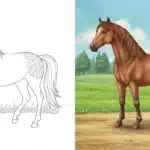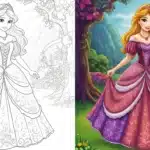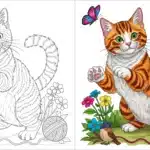We offer a wide collection of free, high-quality printable coloring pages for kids and adults. From cute animals to intricate mandalas, our designs bring creativity and relaxation to everyone. Download, print, and start coloring today!

Are you looking for engaging ways to help your little one learn the alphabet? As a parent and early childhood educator, I’ve discovered that alphabet coloring pages are absolute magic when it comes to making letter learning fun and memorable. These simple yet powerful tools combine creativity with education, giving children a hands-on way to explore letters while developing essential skills.
Whether you’re a parent seeking quiet-time activities, a teacher planning literacy centers, or a homeschooling family looking for engaging resources, this comprehensive guide will provide you with everything you need. I’ll share the best free printable alphabet coloring pages, explain their educational benefits, and give you creative ideas to maximize their learning potential.
Quick Navigation
- Standard Alphabet Sets
- Themed Alphabet Collections
- Educational Variations
- The Benefits of Alphabet Coloring
- How to Use These Pages Effectively
- Creative Extension Activities
Part 1: The Ultimate Alphabet Coloring Page Collection



























Table of Contents
Standard Alphabet Coloring Pages Sets
Let’s start with the foundation – classic letter coloring pages that every child needs. These timeless designs focus purely on letter recognition and formation.
Uppercase Letters
Large, bold uppercase letters are perfect for beginning learners. These abc coloring pages feature clean, simple designs that allow children to focus on the letter shape without distractions. Each letter fills most of the page, making it easy for small hands to color within the lines.
The beauty of uppercase letters lies in their simplicity and recognition factor. Most children encounter capital letters first in their environment – on signs, books, and toys. Starting with these familiar shapes builds confidence and creates positive associations with learning.
Lowercase Letters
Once children master uppercase recognition, lowercase letter coloring pages become essential. These pages help bridge the gap between capital and small letters, a crucial step in reading development. The designs maintain the same clean aesthetic while introducing the unique shapes of lowercase letters.
Many children find lowercase letters more challenging due to their varied sizes and shapes. Coloring activities make this learning process enjoyable rather than frustrating, allowing kids to explore each letter’s unique characteristics at their own pace.
Combined Upper and Lowercase
For children ready for the next challenge, pages featuring both versions of each letter side-by-side are incredibly valuable. These free printable alphabet coloring pages help children understand that each letter has two forms while reinforcing the connection between them.
These dual-format pages work especially well for kindergarten-aged children who are beginning to recognize that the “A” in “APPLE” is the same letter as the “a” in “apple.” The visual comparison strengthens neural pathways and improves letter recognition skills.
Themed Alphabet Coloring Pages Collections
Themed alphabet sets transform basic letter learning into exciting adventures. These engaging designs capture children’s imagination while reinforcing letter-sound connections.
Animal Alphabet Coloring Pages
Nothing captures a child’s attention quite like animals! These letter coloring pages feature each letter paired with a corresponding animal – “A” with an adorable alligator, “B” with a friendly bear, and so on. The combination of letter recognition and animal identification creates multiple learning opportunities in one activity.
Animal-themed pages work particularly well because they naturally introduce phonics concepts. As children color the “C” with a cat, they begin connecting the letter’s appearance with its sound. This multi-sensory approach strengthens memory formation and makes learning stick.
Food Alphabet Coloring Pages
Who doesn’t love thinking about delicious treats? Food-themed alphabet coloring pages make letter learning deliciously fun. From apples to zucchini, these pages introduce children to both familiar and new foods while reinforcing letter shapes.
Food themes also provide excellent opportunities for vocabulary expansion. Children learn new words like “quinoa” for Q or “xigua” (Chinese watermelon) for X, broadening their knowledge beyond basic letter recognition.
Object Alphabet Coloring Pages
Everyday objects make letter learning relevant and practical. These pages feature common items children recognize from their daily lives – balls, cars, doors, and more. This familiarity helps children make immediate connections between letters and the world around them.
Object-themed pages work wonderfully for building vocabulary and encouraging observation skills. Children begin noticing letters everywhere once they’ve colored and discussed these familiar items.
Nature Alphabet Coloring Pages
Flowers, trees, clouds, and rainbows bring the beauty of nature into alphabet learning. These peaceful designs often have a calming effect on children while introducing them to natural elements and seasonal concepts.
Nature themes also provide opportunities to discuss environmental awareness and scientific concepts appropriate for young learners. Simple conversations about how flowers grow can emerge naturally from coloring activities.
Educational Variations
These specialized designs combine multiple learning objectives, making every coloring session a comprehensive educational experience.
Letter Tracing and Coloring
These innovative pages combine pre-writing practice with creative expression. Children can trace the letter multiple times before coloring the main design, reinforcing proper letter formation through repeated practice.
The tracing component is particularly valuable for children developing fine motor skills. The act of following the letter’s path repeatedly helps build muscle memory that transfers directly to writing practice later.
“Letter is for…” Coloring Pages
These comprehensive pages feature the letter, a corresponding image, and the word spelled out. For example, “A is for Apple” pages include a large A, an apple illustration, and the word “APPLE” for children to color and trace.
These multi-element pages support several learning goals simultaneously – letter recognition, phonics awareness, sight word development, and vocabulary building. They’re particularly effective for children who learn best through visual and kinesthetic methods.
Part 2: The Benefits of Alphabet Coloring Pages
Fine Motor Skills Development
Coloring isn’t just fun – it’s fundamental preparation for writing success. When children grasp crayons and carefully color within lines, they’re developing the precise hand movements needed for letter formation.
The controlled movements required for coloring strengthen the small muscles in fingers and hands. These same muscles will later guide pencils to form letters, numbers, and words. Think of coloring as weight training for tiny hands!
Each coloring session also improves hand-eye coordination as children learn to control their movements while watching the results on paper. This coordination becomes crucial when children begin writing and need to make their hands create the letters their minds envision.
Enhanced Letter Recognition
Visual familiarity breeds recognition success. When children spend time coloring letters, they’re creating strong visual memories of each letter’s unique shape and characteristics. The act of slowly tracing around letter edges with color helps children notice important details like curves, lines, and angles.
This focused attention to letter shapes translates directly to reading success. Children who have colored letters extensively often recognize them more quickly in books and environmental print. The combination of visual input and motor movement creates powerful learning connections in developing brains.
Phonics and Sound Association
Themed alphabet coloring pages naturally introduce phonics concepts. As children color “B is for Butterfly,” they begin associating the letter’s visual appearance with its sound. This connection forms the foundation for reading success.
Repetitive exposure to letter-sound relationships through enjoyable activities helps these connections become automatic. When children eventually encounter these letters in words, they’ll have strong phonetic foundations to support their reading efforts.
Creativity and Self-Expression
Coloring provides a safe space for creative exploration. Children can choose their own colors, experiment with different techniques, and express their personalities through their artistic choices. This creative freedom builds confidence and encourages independent thinking.
The open-ended nature of coloring also provides emotional benefits. Children can work at their own pace, take breaks when needed, and feel successful regardless of their skill level. This positive learning environment encourages continued engagement with educational activities.
Focus and Concentration
In our fast-paced world, helping children develop focus skills is more important than ever. Coloring naturally encourages sustained attention as children work to complete their pictures. This focused practice transfers to other learning activities and academic tasks.
The meditative quality of coloring also helps children learn to calm themselves and regulate their emotions. These self-regulation skills prove invaluable throughout their educational journey and beyond.
How to Use These Pages Effectively
For Parents: Creating Magic at Home
Transform your kitchen table into a learning laboratory with these simple strategies. Set up a special “letter learning station” with easy access to crayons, colored pencils, and fresh coloring pages. Having everything readily available makes it simple to incorporate alphabet coloring pages practice into daily routines.
Create an “alphabet wall” where you display completed coloring pages in alphabetical order. This visual display serves as both decoration and learning tool, allowing children to see their progress while providing reference for letter recognition practice.
Consider making personalized alphabet coloring pages books by binding completed pages together. Children love seeing their artwork compiled into “real” books, and these homemade creations become treasured keepsakes while serving as ongoing learning resources.
For Teachers: Classroom Integration Ideas
Alphabet coloring pages work beautifully in various classroom settings. Use them as morning warm-up activities, literacy center rotations, or calm-down tools during transitions. Their versatility makes them valuable additions to any early childhood classroom.
Implement “Letter of the Week” celebrations where children color and discuss one letter thoroughly. This focused approach allows deep exploration of each letter’s characteristics, sounds, and associated vocabulary. Display the week’s letter prominently and encourage children to find it throughout the classroom environment.
Create differentiated learning opportunities by offering various difficulty levels simultaneously. Advanced learners can work on tracing activities while beginners focus on simple coloring. This approach ensures every child feels challenged and successful.
For Homeschooling Families: Flexible Learning
Homeschooling families can integrate alphabet coloring into larger thematic units. If you’re studying farm animals, use animal alphabet pages to reinforce both letter learning and your current topic. This cross-curricular approach maximizes learning while maintaining engagement.
Use coloring time as opportunities for one-on-one instruction. Sit with your child and discuss the letters, sounds, and images while they color. These informal conversations often lead to breakthrough learning moments that formal instruction might miss.
Creative Extension Activities
Color and Chat Conversations
Transform coloring time into rich learning experiences through guided conversations. Ask open-ended questions like “What other things start with this letter?” or “What color do you think this animal really is?” These discussions expand vocabulary and encourage critical thinking.
Share personal stories related to the letters or images. When coloring “D is for Dog,” tell stories about family pets or dogs you’ve known. These connections make learning personal and memorable while building oral language skills.
Letter Scavenger Hunts
After completing a coloring page, challenge children to find real-world examples of their featured letter. This activity bridges the gap between paper learning and environmental awareness while encouraging active observation skills.
Create photo collections of found letters using smartphones or cameras. Children love documenting their discoveries, and these photo albums become personalized learning tools for review and reinforcement.
Multi-Sensory Letter Exploration
Extend coloring activities into three-dimensional learning experiences. After coloring the letter “S,” practice making the “S” sound, form the letter shape with play dough, or trace it in sand or finger paint. These varied experiences reinforce learning through multiple sensory channels.
Create letter-themed snacks to match coloring activities. Enjoy apple slices while working on “A” pages or carrot sticks with “C” pages. These connections make learning memorable and enjoyable while introducing healthy eating habits.
Building Letter Books
Encourage children to create their own alphabet books using completed coloring pages. This project gives purpose to their artwork while creating lasting learning resources. Children can add their own words, drawings, or photos to personalize each page.
Bookmaking activities develop sequencing skills, creativity, and pride in learning accomplishments. These homemade books often become beloved bedtime reading material, reinforcing letter learning during quiet moments.
Maximizing Educational Impact
Age-Appropriate Expectations
Remember that every child develops at their own pace. Two-year-olds might simply enjoy the sensory experience of coloring, while five-year-olds can discuss letter sounds and write words. Adjust your expectations and celebrate progress at every level.
Focus on effort and engagement rather than perfection. A scribbled attempt shows learning in progress, while a perfectly colored page might indicate a child who’s ready for greater challenges. Both achievements deserve recognition and encouragement.
Creating Learning Routines
Consistency builds success in alphabet learning. Establish regular coloring times that children can anticipate and look forward to. This routine creates positive associations with learning while ensuring steady progress toward literacy goals.
Consider pairing coloring activities with other learning elements like letter songs, books, or games. This comprehensive approach addresses different learning styles while reinforcing concepts through multiple modalities.
Assessment Through Observation
Watch for signs of progress during coloring activities. Notice when children begin recognizing letters spontaneously or making sound connections independently. These informal assessments provide valuable insights into learning progress without formal testing pressure.
Document growth through photos of completed work over time. This visual record shows both you and your child how skills develop and improve, building confidence and motivation for continued learning.
Supporting Different Learning Styles
Visual Learners
Visual learners thrive with alphabet coloring pages because they process information best through sight. The combination of letter shapes, colors, and associated images creates rich visual memories that support long-term retention.
Enhance visual learning by using bright, contrasting colors and encouraging children to notice details in letter shapes. Point out similarities and differences between letters, helping children build visual discrimination skills essential for reading success.
Kinesthetic Learners
Children who learn through movement and touch benefit enormously from the physical act of coloring. The hand movements involved in coloring create muscle memories that support letter recognition and formation.
Encourage kinesthetic learners to trace letters with their fingers before coloring, use different textures like crayons and markers, and incorporate full-body movements like “writing” letters in the air while discussing their work.
Auditory Learners
Support auditory learners by incorporating sounds, songs, and discussions into coloring activities. Sing alphabet songs while coloring, make letter sounds repeatedly, and engage in rich conversations about the letters and images.
Read books featuring the same letters children are coloring, creating audio-visual connections that strengthen learning. The combination of hearing and seeing letters simultaneously creates powerful learning experiences for auditory processors.
Troubleshooting Common Challenges
Short Attention Spans
If children lose interest quickly, try shorter coloring sessions with high-energy transitions between activities. Five minutes of focused coloring followed by movement or singing can be more effective than lengthy sessions that lead to frustration.
Choose coloring pages with simpler designs for children with shorter attention spans. Less detailed images allow for quicker completion and more frequent success experiences.
Perfectionism Concerns
Some children become frustrated when their coloring doesn’t meet their personal standards. Encourage experimentation and emphasize the process over the product. Model imperfect coloring yourself, showing that learning involves trying and improving rather than immediate perfection.
Celebrate unique color choices and creative interpretations. When children color elephants purple or suns green, praise their creativity rather than correcting their choices. This approach builds confidence and maintains enthusiasm for learning activities.
Developmental Differences
Children develop at vastly different rates, and that’s perfectly normal. Some three-year-olds might trace letters accurately while some five-year-olds still struggle with crayon control. Meet each child where they are and celebrate their individual progress.
Provide various difficulty levels simultaneously so children can choose appropriate challenges. Having both simple and complex options available prevents frustration while encouraging growth.
Making Learning Stick: Long-Term Strategies
Consistent Practice
Regular exposure to alphabet coloring pages creates cumulative learning benefits. Short, frequent sessions work better than occasional marathon coloring times. Even ten minutes daily can produce significant progress over time.
Rotate through different types of pages to maintain interest while ensuring comprehensive letter exposure. This variety prevents boredom while systematically covering all learning objectives.
Positive Associations
Always maintain positive, encouraging attitudes during coloring activities. Your enthusiasm becomes contagious, helping children develop genuine excitement about letter learning. Avoid turning coloring into high-pressure performance situations.
Celebrate every attempt and improvement, no matter how small. This positive reinforcement encourages continued effort and builds intrinsic motivation for learning activities.
Real-World Connections
Help children connect their coloring experiences to everyday life. Point out letters in grocery stores, on street signs, and in books. These connections demonstrate the practical importance of letter knowledge while reinforcing learning.
Encourage children to share their coloring accomplishments with family members and friends. This sharing builds pride in learning achievements while providing additional practice opportunities through explanations and discussions.
More Fun Coloring Adventures Await
Looking for even more coloring fun? Check out our other popular collections:
- Unicorn Coloring Pages – Download them all in one click or pick your favorites below.
- Horse Coloring Pages – Download them all in one click or pick your favorites below.
- Princess Coloring Pages – Download them all in one click or pick your favorites below.
- Monster Truck Coloring Pages – Download them all in one click or pick your favorites below.
- Stitch Coloring Pages – Download them all in one click or pick your favorites below.
- Squishmallow Coloring Pages – Download them all in one click or pick your favorites below.
- Car Coloring Pages – Download them all in one click or pick your favorites below.
- Summer Coloring Pages – Download them all in one click or pick your favorites below.
Conclusion: Building Bright Futures Through Simple Activities
Free printable alphabet lore coloring pages offer incredible value for children’s educational development. These simple tools combine letter recognition, fine motor development, creativity, and focus training into enjoyable activities that children request rather than resist.
The beauty of alphabet lore coloring pages lies in its accessibility and flexibility. Whether you have five minutes or an hour, these pages adapt to your schedule while providing consistent learning benefits. Every colored letter represents progress toward reading readiness and academic success.
Remember that learning happens gradually through repeated positive experiences. Your child’s scribbled “A” today becomes tomorrow’s perfectly formed letter. Each coloring session builds essential skills while creating happy memories around learning activities.
As you embark on this alphabet coloring pages adventure with your child, celebrate the journey rather than rushing toward destinations. These precious learning moments pass quickly, but the foundations you’re building through simple coloring activities will support your child’s educational success for years to come.
The investment of time and attention you make today in alphabet coloring pages activities pays dividends in reading confidence, academic preparedness, and positive learning attitudes. So grab those crayons, print some pages, and enjoy watching your child discover the magical world of letters through the simple joy of coloring.
Start your alphabet lore coloring pages journey today and witness how these humble letter coloring pages transform into powerful stepping stones toward literacy success. Your child’s future reading adventures begin with these colorful first steps!




